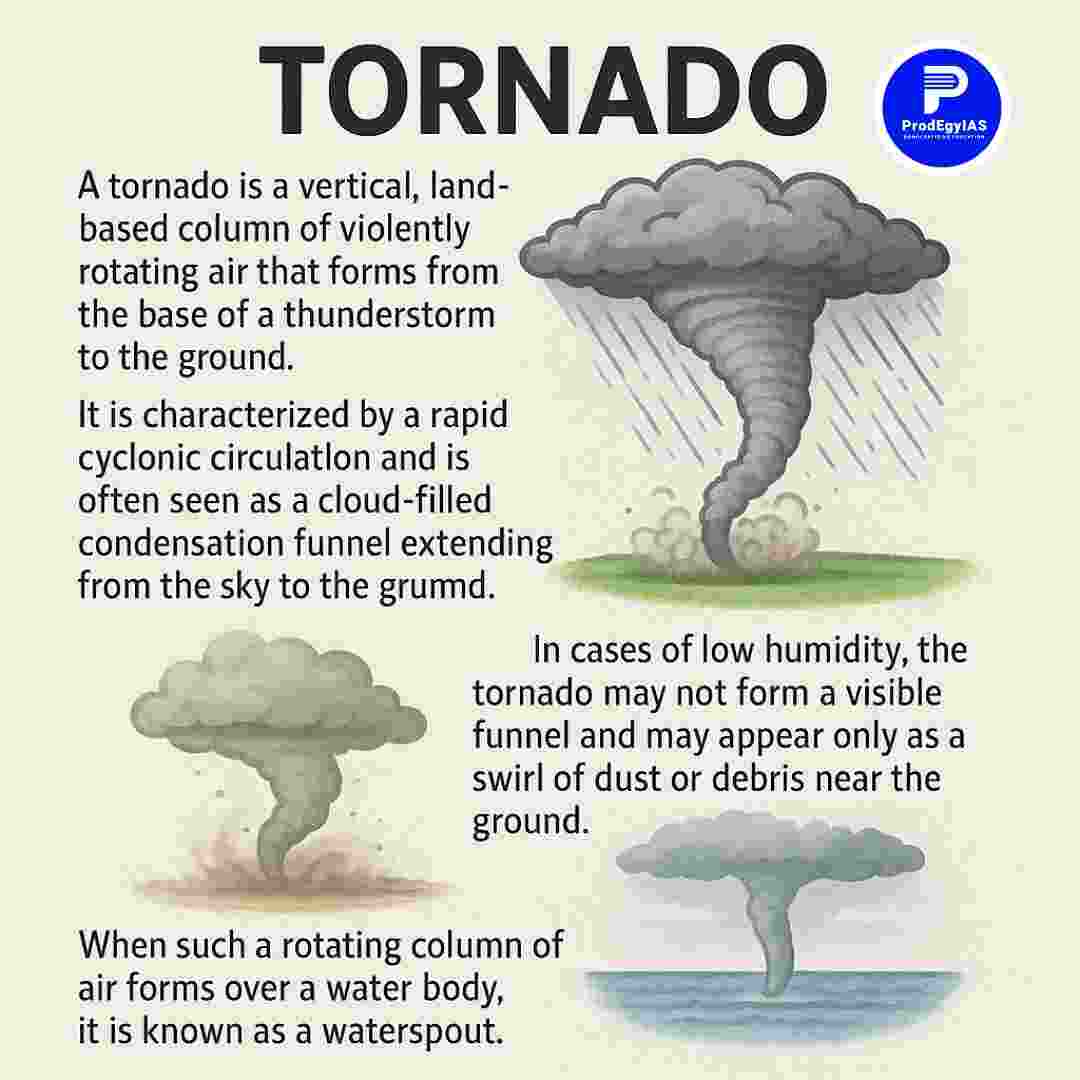Relevance: GS I: Geographical phenomena
Table of Contents
ToggleRecent Context
More than 20 people are killed by tornadoes and severe weather in the US. Almost 200,000 people have lost power as a result of severe storms that have ravaged southern and midwestern states like Kentucky and Missouri, leaving a path of devastation and fatalities in their wake.
What is a Tornado?
A tornado is a thin column of air that stretches from a thunderstorm to the ground and rotates violently. Unless a tornado generates a condensation funnel composed of water droplets, dust, and debris, it is difficult to notice because wind is invisible. Of all the atmospheric storms we encounter, tornadoes can be some of the most violent.
Note: Stay informed about the most recent UPSC current Affairs, where we provide clear explanations of the major stories.

Difference between tornadoes and waterspouts
Waterspouts and tornadoes are similar in that they are both simply towers of wind that rotate with great force. The main distinction is that tornadoes typically occur over dry land, while waterspouts happen over a body of water. Because there is typically less in its path to destroy, waterspouts are a form of tornado that is typically weaker and less destructive.
Where Do Tornadoes Occur?
Typically, tornadoes happen in the middle of the day until early evening. Usually, they travel from the southwest to the northeast. They can occasionally go in any direction along the thunderstorm’s overall course. About 300 to 400 yards are covered by the spinning winds, which can reach 5 to 60 miles at a speed of 5 to 60 miles (some tornadoes can travel beyond 80 miles).
Profiles of Tornadoes
The Fujita Tornado Damage Scale is used to quantify the severity of tornadoes, which are divided into six categories and range from F0 to F5.
F0—LIGHT:
These are strong winds that rarely cause damage to poorly maintained roofs. Trash cans and other lightweight items may be displaced by these gusts. They happen often, accounting for over 60% of all tornadoes that occur each year.
F1—MODERATE:
This accounts for roughly 28% of all tornadoes. They break windows, injure young trees, and inflict minor damage to building roofs and the landscape. They have the ability to move heavier items.
F2—CONSIDERABLE:
This accounts for roughly 9% of the total. They bend trees and shatter their branches. The flying debris they produce causes significant property damage. If a garden shed has weak foundations, they can move and displace it.
F3— SEVERE:
These have the power to destroy building walls and uproot trees. They can seriously destroy buildings and tear off roofs. Approximately 3% of tornadoes are of this type, and their devastation frequently makes the TV news.
F4—DEVASTATING:
Small cars are blown over and displaced, making these quite destructive. Trees are uprooted and blown away, and well-built dwellings are broken. They wreck everything in their path and carry hefty debris. They only comprise around 1%.
Note: To take practice tests on Daily current Affairs MCQs, click the link that is attached.
| MCQ Question: Consider the following statements regarding tornadoes:
Which of the above statements is/are correct? a) 1 only b) 1 and 3 only c) 2 and 3 only d) 1, 2 and 3 Answer: b) 1 and 3 only |
Source: Severe weather, tornadoes kill over 20 people
UPSC General Studies Paper Preparation
| Topic | |
| UPSC Syllabus | GS Genius-50 Program |
| Public administration crash course | UPSC GS Mains 2025 Study Material |
| About the Author: Nitin Kumar Singh |



